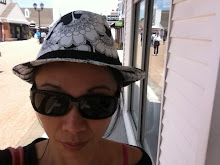The twins are doing science this year.
They spent much of last year excited about doing science this year. They read, they watched videos and they spewed scary non-sequiturs about poisonous/ deadly animals. They taught me the difference between a poisonous creature and a venomous one.
Unfortunately, school science is not just about remembering crazy facts but actually being able to make observations about these creatures or phenomena. That bit is what we've been trying to help them bridge; articulating all their weird, random bits of information into coherent observations.
The wonderful thing about science is that it's all around, especially now as they tackle living things as a topic. I discovered one morning after dropping the twins off that one of their schools faced a bank of wild vegetation. Peering at the various plants and trees by the pathway, I noticed with a great amount of glee, an army of different sorts of trees and shrubs as well as leaves housing spiders and leaves folded downwards because of sacs of spider eggs. Time to bring them on a nature ramble.
That's when I decided that I was going to make their textbook real to them. Part of what the twins are doing is to identify the different characteristics of leaves. Once again, it's about observation. So, armed with the scissors from my very guniang Swiss Knife and a plastic bag that Muffin had carelessly tossed at the back of the car, I braved commando mosquitoes and started clipping off different leaves.
So yesterday's revision for next week's Science test was to set up their leaf scrap book, identify and list the various characteristics of each of the leaves after pasting them in. Of course from the academic point of view, it's a small section of what they need to know but it was fun and they'll remember it past their use of the scrap book.

Another part of the topic required them to learn the functions of the different parts of the plant. They could learn it by heart or they could see it. I opted for them to see how plants and their system for transporting water worked. To do this, all that was necessary was food colouring, big jars and leaves of Chinese cabbage.
Wednesday, March 02, 2016
Experiment 1: Nature study
They marvelled at how quickly the water was transported to the tips of the leaves, how the tips of the leaves coloured first and how extensively the network of veins was. And the added bonus was that it was very very pretty.
If these questions were asked next week, it would be a bonus. If they didn't, at least they'd know how to make very pretty coloured flowers next time.
Subscribe to:
Post Comments (Atom)







0 comments:
Post a Comment